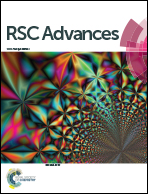Modifications of the CZTSe/Mo back-contact interface by plasma treatments†
Abstract
Molybdenum (Mo) is the most commonly used back-contact material for copper zinc tin selenide (CZTSe)-based thin-film solar cells. For most fabrication methods, an interfacial molybdenum diselenide (MoSe2) layer with an uncontrolled thickness is formed, ranging from a few tens of nm up to ≈1 μm. In order to improve the control of the back-contact interface in CZTSe solar cells, the formation of a MoSe2 layer with a homogeneous and defined thickness is necessary. In this study, we use plasma treatments on the as-grown Mo surface prior to the CZTSe absorber formation, which consists of the deposition of stacked metallic layers and the annealing in selenium (Se) atmosphere. The plasma treatments include the application of a pure argon (Ar) plasma and a mixed argon–nitrogen (Ar–N2) plasma. We observe a clear impact of the Ar plasma treatment on the MoSe2 thickness and interfacial morphology. With the Ar–N2 plasma treatment, a nitrided Mo surface can be obtained. Furthermore, we combine the Ar plasma treatment with the application of titanium nitride (TiN) as back-contact barrier and discuss the obtained results in terms of MoSe2 formation and solar cell performance, thus showing possible directions of back-contact engineering for CZTSe solar cells.



 Please wait while we load your content...
Please wait while we load your content...